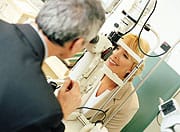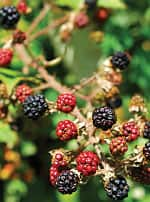Life Extension Magazine®
| In terms of personal safety, getting behind the wheel of a car can be a risky endeavor. But driving a car at night is even riskier. Almost half of all fatal car crashes in the US occur at night.1 Nearly half of all aviation fatalities also take place at night, even though only 7% of all flights are night flights.2 The reason is simple. Humans did not evolve the capacity to see well in poorly lit conditions. As we age, our night vision ability plummets. For example, falls are the number one cause of serious injuries in older people, accounting for 70% of accidental deaths.3 Darkness is often the culprit. Fortunately, cutting-edge researchers have identified a nutrient that not only improves vision—but has the power to regenerate the molecules in your eyes that help you see in darkness. This next-generation nutrient, called cyanidin-3-glucoside or C3G, is found in high concentrations in certain berries native to Europe. In a clinical study on the effects of a concentrated berry extract containing C3G, a group of aging individuals taking just 50 mg experienced improvement in their ability to see in darkness after just 30 minutes!4 In this article, you will learn how this novel plant-based nutrient acts in multiple ways to enhance eyesight and nourish the structures you need to see in dim-light conditions. You will also find out how an international research team recently established C3G’s pharmacologic power to improve eyesight at night. A Breakthrough Discovery: Vision Regeneration
As we age, our ability to see in the dark is impaired. The reason is that a compound in our eyes called rhodopsin (which absorbs light in our retina) dramatically declines over time. Aging is directly associated with a reduction in the ability of rhodopsin to regenerate, resulting in progressive loss of dark vision.5 Researchers have discovered a novel solution to the problem of declining night vision called C3G, which is short way of saying cyanidin-3-glucoside. C3G is a purple pigment in the anthocyanin family of flavonoid molecules. It is found in highest concentrations in dark fruits like blackberries and black currants.6,7 Like most flavonoids, it is a powerful antioxidant8—a critical protective factor in the high-energy environment of the retina, where continuously flowing electrons and photons produce damaging free radical surges.9 C3G is a purple pigment in the anthocyanin family of flavonoid molecules. It is found in highest concentrations in dark fruits like blackberries and black currants.
Scientific Studies on C3G and the EyeAs early as 2003, Japanese researchers discovered that C3G stimulated rhodopsin regeneration in animal retinal cells.10 These findings were extended with two landmark papers in 2009. The first showed that C3G binds directly to rhodopsin in both its dark- and light-adapted states.11 The second study showed that C3G binding creates a beneficial change in the molecular structure of rhodopsin.12 Remember that rhodopsin is the complex in your retina that absorbs light. By opening up the binding site for a pigment known as retinal, C3G speeds the regeneration of rhodopsin. It’s that rapid regeneration of rhodopsin that makes C3G so exciting to vision scientists for its potential to enhance night vision. A supportive study involving a group of healthy volunteers found that just 50 mg of a berry extract concentrate containing C3G helped aging individuals to see better in darkness after 30 minutes.4 Scientific Studies on How C3G Benefits Other Tissues
Interestingly, C3G, which is highly bioavailable, enhances other functions in the body.13-15 Its potent antioxidant properties protect tissues against DNA damage, often the first step in cancer formation and aging of tissues.16,17 C3G protects endothelial cells against peroxynitrite-induced endothelial dysfunction and vascular failure.18 In addition, C3G fights inflammation by inhibiting inducible nitric oxide synthase (iNOS), reducing vascular inflammation.19 At the same time C3G upregulates activity of endothelial nitric oxide synthase (eNOS), which helps maintain normal vascular function.20 These effects on blood vessels are especially important in the retina, where delicate nerve cells depend on the single ophthalmic artery for their sustenance. In animal models, C3G prevents obesity and ameliorates blood sugar elevations.21 One way it does this is by increasing gene expression of the beneficial fat-related cytokine adiponectin.22 As we well know, diabetics are predisposed to severe eye problems including blindness from elevated blood sugar levels. C3G helps to induce apoptosis (programmed cell death) in a number of human cancer lines, an important step in cancer prevention.23,24 In a similar fashion (but via a different mechanism), C3G stimulates rapidly proliferating human cancer cells to differentiate so that they more closely resemble normal tissue.25 Finally, in early 2010, it was discovered that C3G is neuroprotective, helping to prevent the disastrous effects of the Alzheimer’s-related protein amyloid beta on brain cells.26 C3G acts at multiple targets throughout the body to protect vision. To achieve maximum eye protection, C3G works in concert with other nutrients that guard eyes from the many age-related threats to vision. Protecting the MaculaUp until middle age, our retinas are protected from the onslaught of severe damage from intense sunlight. We owe the natural light protection in our youthful retinas to a group of plant-derived molecules called carotenoid xanthophylls. The retina contains 3 kinds of carotenoids, of which two, lutein and zeaxanthin, predominate.27 With the addition of meso-zeaxanthin (which in young eyes is formed from lutein), these carotenoids account for the “yellow spot” at the macula.28,29
The macula is the part of the retina on which most light falls, and is therefore most vulnerable to light-induced damage.29 It’s no coincidence that carotenoids are concentrated in the macula: their yellow pigment is a function of their molecular structure, which allows them to avidly absorb the blue light that is most destructive to retinal cells.30,31 These pigments also have powerful antioxidant properties, helping them rapidly quench oxygen free radicals produced by photons striking retinal tissue.29,32 But macular pigments decline with age, leaving the retina increasingly unshielded from harsh radiation. In fact, as pigment levels drop, the incidence of age-related macular degeneration increases. Macular degeneration is the leading cause of blindness in the elderly.31 Because it destroys vision in the center of the visual field, macular degeneration has a tremendous impact on one’s ability to recognize faces, to drive, and to read, contributing to the growing isolation that’s so devastating to elderly people.33 Sadly, the average intake of carotenoid pigments in the US is below the levels known to afford protection from eye disease.34 There’s compelling evidence that dietary deficiencies in these nutrients contribute to eye diseases such as macular degeneration and cataracts.35,36 Fortunately, there’s equally unequivocal evidence that supplementation offers protection.36 Let’s take a look. It’s been known for years that higher dietary intakes of lutein and zeaxanthin were associated with decreased likelihood of age-related macular degeneration.37 More recently, higher blood levels of carotenoids were found to be associated with preventing cataracts as well.38,39 But simply increasing one’s intake of fruits and vegetables rich in these pigments, while beneficial for overall health, has failed to affect the concentration of carotenoids in the retina.40 To do that, supplementation is required.
The large Lutein Antioxidant Supplementation Trial (LAST) was designed to determine the effects of supplementation on density of macular pigments in people with age-related macular degeneration.41 Subjects received 10 mg lutein alone; lutein with vitamins, minerals, and antioxidants; or a placebo. The density of macular pigment increased in both supplemented groups, and declined significantly in the placebo recipients. Most vitally, this study established that people with the lowest pigment density (and therefore in greatest need of supplementation), obtained the greatest benefit from supplementation. The authors concluded that “If a deficiency in macular pigment optical density is accurately diagnosed, effective interventions should be able to re-establish this prophylactic barrier.”41 A study by Italian ophthalmologists advanced our knowledge by an additional step.42 Studying people with early age-related macular degeneration, they demonstrated a remarkable increase in the electrical response to light of subjects’ retinas following supplementation with lutein 10 mg, zeaxanthin 1 mg, and astaxanthin 4 mg, along with antioxidant vitamins and minerals. This was the first study to show that supplements improve retinal function.
Numerous other studies have confirmed and elaborated on these results. Lutein in combination with docosahexaenoic acid (DHA from fish oil) provided an increase in pigment density evenly throughout the retina.43 A 2010 trial demonstrated increased macular pigmentation, especially in the crucial central portion of the retina, after just 2 weeks of supplementation with lutein, zeaxanthin, and meso-zeaxanthin.44 The combination of lutein plus zeaxanthin provides the best coverage of pigment in both central and peripheral areas of the retina.45 Supplementation with lutein, zeaxanthin, and black currant extract has also been shown to reduce symptoms of visual fatigue, a common problem with advancing age.46 Cataracts are another leading cause of vision loss in older adults, and one we now know may be preventable with supplementation. People with higher intakes of lutein and zeaxanthin are at decreased risk for cataracts.39,47,48 Laboratory studies demonstrated that lutein inhibits changes that contribute to cataracts in both normal and diabetic eyes.49,50 Finally, lutein supplements improved visual function in people with age-related cataracts.51 Unique Mechanisms of Meso-zeaxanthin and AstaxanthinWhile lutein and zeaxanthin are the main xanthophylls in the retina, lutein is also transformed into meso-zeaxanthin in the retina itself.31 Meso-zeaxanthin is found only in a few foods, such as shrimp shells and fish skin—hardly appealing sources for this valuable nutrient.27 Fortunately, meso-zeaxanthin is readily absorbed into the blood following oral supplementation, and it contributes significantly to improving macular pigment density when used as a supplement. Light not only depletes the retina of protective pigments, it also induces powerful oxidant stresses that result in inflammatory responses in both retina and lens. Another xanthophyll, the red pigment astaxanthin, provides comprehensive protection against these threats.52,53 In fact, astaxanthin in combination with lutein and zeaxanthin protected human lens tissue from ultraviolet light damage better than vitamin E.54 Cataracts are another leading cause of vision loss in older adults, and one we now know may be preventable with supplementation.
Inflammatory changes in the retina contribute to long-term retinal damage, mostly through their impact on the health of tiny blood vessels within the eye. Astaxanthin reduces inflammation in the eye by the following mechanisms:
Astaxanthin’s anti-inflammatory effects also protect retinal tissue from so-called “wet” age-related macular degeneration by reducing the formation of new blood vessels seen in advanced disease.58 Finally, astaxanthin protects retinal cells from dying as the result of the increased pressure within the eye that characterizes glaucoma, another tragic cause of blindness in the elderly.59 SummaryNearly half of all automobile and aviation fatalities occur at night. Dim-lighting conditions are a major factor in falls, the leading cause of accidental death in older persons. This horrific death toll stems primarily from the fact that human beings did not evolve the capacity to see well in darkness. Researchers have recently uncovered the power of berry flavonoid compounds such as cyanidin-3-glucoside or C3G to optimize eyesight and enhance night vision. It favorably affects molecular processes that speed restoration of the eye pigment rhodopsin—the primary catalyst for optimized night vision. (See sidebar below for details.) Lutein, zeaxanthin, and meso-zeaxanthin help protect retinal and lens tissue from light damage, helping to prevent macular degeneration and cataracts. Astaxanthin provides additional protection against inflammatory changes that can worsen macular degeneration, as well as against elevated pressure from glaucoma. These nutrients provide benefits to cells throughout the body. If you have any questions on the scientific content of this article, please call a Life Extension® Health Advisor at
| |||||||||
| References | |||||||||
| 1. Available at: www.forbes.com/2009/01/21/car-accident-times-forbeslife-cx_he_0121driving.html. Accessed August 13, 2010. 2. Available at: http://4vfr.com/?goto=view_article§ion=articles&article_key=300. Accessed August 10, 2010. 3. Available at: http://www.aafp.org/afp/20000401/2159.html. Accessed August 10, 2010. 4. Nakaishi H, Matsumoto H, Tominaga S, Hirayama M. Effects of black currant anthocyanoside intake on dark adaptation and VDT work-induced transient refractive alteration in healthy humans. Alt Med Rev. 2000 Dec;5(6):553-62. 5. Jackson GR, Owsley C, McGwin G Jr. Aging and dark adaptation. Vision Res. 1999 Nov;39(23):3975-82. 6. Guerra MC, Galvano F, Bonsi L, et al. Cyanidin-3-O-beta-glucopyranoside, a natural free-radical scavenger against aflatoxin B1- and ochratoxin A-induced cell damage in a human hepatoma cell line (Hep G2) and a human colonic adenocarcinoma cell line (CaCo-2). Br J Nutr. 2005 Aug;94(2):211-20. 7. Kapasakalidis PG, Rastall RA, Gordon MH. Extraction of polyphenols from processed black currant (Ribes nigrum L.) residues. J Agric Food Chem. 2006 May 31;54(11):4016-21. 8. Amorini AM, Fazzina G, Lazzarino G, et al. Activity and mechanism of the antioxidant properties of cyanidin-3-O-beta-glucopyranoside. Free Radic Res. 2001 Dec;35(6):953-66. 9. Wu J, Seregard S, Algvere PV. Photochemical damage of the retina. Surv Ophthalmol. 2006 Sep-Oct;51(5):461-81. 10. Matsumoto H, Nakamura Y, Tachibanaki S, Kawamura S, Hirayama M. Stimulatory effect of cyanidin 3-glycosides on the regeneration of rhodopsin. J Agric Food Chem. 2003 Jun 4;51(12):3560-3. 11. Yanamala N, Tirupula KC, Balem F, Klein-Seetharaman J. pH-dependent interaction of rhodopsin with cyanidin-3-glucoside. 1. Structural aspects. Photochem Photobiol. 2009 Mar-Apr;85(2):454-62. 12. Tirupula KC, Balem F, Yanamala N, Klein-Seetharaman J. pH-dependent interaction of rhodopsin with cyanidin-3-glucoside. 2. Functional aspects. Photochem Photobiol. 2009 Mar-Apr;85(2):463-70. 13. Miyazawa T, Nakagawa K, Kudo M, Muraishi K, Someya K. Direct intestinal absorption of red fruit anthocyanins, cyanidin-3-glucoside and cyanidin-3,5-diglucoside, into rats and humans. J Agric Food Chem. 1999 Mar;47(3):1083-91. 14. Tsuda T, Horio F, Osawa T. Absorption and metabolism of cyanidin 3-O-beta-D-glucoside in rats. FEBS Lett. 1999 Apr 23;449(2-3):179-82. 15. Matsumoto H, Inaba H, Kishi M, Tominaga S, Hirayama M, Tsuda T. Orally administered delphinidin 3-rutinoside and cyanidin 3-rutinoside are directly absorbed in rats and humans and appear in the blood as the intact forms. J Agric Food Chem. 2001 Mar;49(3):1546-51. 16. Acquaviva R, Russo A, Galvano F, et al. Cyanidin and cyanidin 3-O-beta-D -glucoside as DNA cleavage protectors and antioxidants. Cell Biol Toxicol. 2003 Aug;19(4):243-52. 17. Riso P, Visioli F, Gardana C, et al. Effects of blood orange juice intake on antioxidant bioavailability and on different markers related to oxidative stress. J Agric Food Chem. 2005 Feb 23;53(4):941-7. 18. Serraino I, Dugo L, Dugo P, et al. Protective effects of cyanidin-3-O-glucoside from blackberry extract against peroxynitrite-induced endothelial dysfunction and vascular failure. Life Sci. 2003 Jul 18;73(9):1097-114. 19. Pergola C, Rossi A, Dugo P, Cuzzocrea S, Sautebin L. Inhibition of nitric oxide biosynthesis by anthocyanin fraction of blackberry extract. Nitric Oxide. 2006 Aug;15(1):30-9. 20. Xu JW, Ikeda K, Yamori Y. Cyanidin-3-glucoside regulates phosphorylation of endothelial nitric oxide synthase. FEBS Lett. 2004 Sep 10;574(1-3):176-80. 21. Tsuda T, Horio F, Uchida K, Aoki H, Osawa T. Dietary cyanidin 3-O-beta-D-glucoside-rich purple corn color prevents obesity and ameliorates hyperglycemia in mice. J Nutr. 2003 Jul;133(7):2125-30. 22. Tsuda T, Ueno Y, Aoki H, et al. Anthocyanin enhances adipocytokine secretion and adipocyte-specific gene expression in isolated rat adipocytes. Biochem Biophys Res Commun. 2004 Mar 26;316(1):149-57. 23. Fimognari C, Berti F, Nusse M, Cantelli-Forti G, Hrelia P. Induction of apoptosis in two human leukemia cell lines as well as differentiation in human promyelocytic cells by cyanidin-3-O-beta-glucopyranoside. Biochem Pharmacol. 2004 Jun 1;67(11):2047-56. 24. Chen PN, Chu SC, Chiou HL, Chiang CL, Yang SF, Hsieh YS. Cyanidin 3-glucoside and peonidin 3-glucoside inhibit tumor cell growth and induce apoptosis in vitro and suppress tumor growth in vivo. Nutr Cancer. 2005;53(2):232-43. 25. Serafino A, Sinibaldi-Vallebona P, Lazzarino G, et al. Differentiation of human melanoma cells induced by cyanidin-3-O-beta-glucopyranoside. FASEB J. 2004 Dec;18(15):1940-2. 26. Tarozzi A, Morroni F, Merlicco A, et al. Neuro-protective effects of cyanidin 3-O-glucopyranoside on amyloid beta (25-35) oligomer-induced toxicity. Neurosci Lett. 2010 Apr 5;473(2):72-6. 27. Thurnham DI. Macular zeaxanthins and lutein--a review of dietary sources and bioavailability and some relationships with macular pigment optical density and age-related macular disease. Nutr Res Rev. 2007 Dec;20(2):163-79. 28. Nolan JM, Kenny R, O’Regan C, et al. Macular pigment optical density in an ageing Irish population: The Irish longitudinal study on ageing. Ophthalmic Res. 2010 Jun 2;44(2):131-9. 29. Subczynski WK, Wisniewska A, Widomska J. Location of macular xanthophylls in the most vulnerable regions of photoreceptor outer-segment membranes. Arch Biochem Biophys. 2010 May 27. 30. Moukarzel AA, Bejjani RA, Fares FN. Xanthophylls and eye health of infants and adults. J Med Liban. 2009 Oct-Dec;57(4):261-7. 31. Krinsky NI, Landrum JT, Bone RA. Biologic mechanisms of the protective role of lutein and zeaxanthin in the eye. Annu Rev Nutr. 2003;23:171-201. 32. Li SY, Lo AC. Lutein protects RGC-5 cells against hypoxia and oxidative stress. Int J Mol Sci. 2010;11(5):2109-17. 33. Bernstein PS. Nutritional interventions against age-related macular degeneration. Acta Hortic. 2009 Aug 31;841:103-12. 34. Renzi LM, Johnson EJ. Lutein and age-related ocular disorders in the older adult: a review. J Nutr Elder. 2007;26(3-4):139-57. 35. Macular pigment and healthy vision. Optometry. 2009 Oct;80(10):592-8. 36. Ma L, Lin XM. Effects of lutein and zeaxanthin on aspects of eye health. J Sci Food Agric. 2010 Jan 15;90(1):2-12. 37. Age-Related Eye Disease Study Research Group, SanGiovanni JP, Chew EY, et al. The relationship of dietary carotenoid and vitamin A, E, and C intake with age-related macular degeneration in a case-control study: AREDS Report No. 22. Arch Ophthalmol. 2007 Sep;125(9):1225-32. 38. Dherani M, Murthy GV, Gupta SK, et al. Blood levels of vitamin C, carotenoids and retinol are inversely associated with cataract in a North Indian population. Invest Ophthalmol Vis Sci. 2008 Aug;49(8):3328-35. 39. Moeller SM, Voland R, Tinker L, et al. Associations between age-related nuclear cataract and lutein and zeaxanthin in the diet and serum in the Carotenoids in the Age-Related Eye Disease Study, an Ancillary Study of the Women’s Health Initiative. Arch Ophthalmol. 2008 Mar;126(3):354-64. 40. Moeller SM, Voland R, Sarto GE, Gobel VL, Streicher SL, Mares JA. Women’s Health Initiative diet intervention did not increase macular pigment optical density in an ancillary study of a subsample of the Women’s Health Initiative. J Nutr. 2009 Sep;139(9):1692-9. 41. Richer S, Devenport J, Lang JC. LAST II: Differential temporal responses of macular pigment optical density in patients with atrophic age-related macular degeneration to dietary supplementation with xanthophylls. Optometry. 2007 May;78(5):213-9. 42. Parisi V, Tedeschi M, Gallinaro G, et al. Carotenoids and antioxidants in age-related maculopathy italian study: multifocal electroretinogram modifications after 1 year. Ophthalmology. 2008 Feb;115(2):324-33.e2. 43. Johnson EJ, Chung HY, Caldarella SM, Snodderly DM. The influence of supplemental lutein and docosahexaenoic acid on serum, lipoproteins, and macular pigmentation. Am J Clin Nutr. 2008 May;87(5):1521-9. 44. Connolly EE, Beatty S, Thurnham DI, et al. Augmentation of macular pigment following supplementation with all three macular carotenoids: an exploratory study. Curr Eye Res. 2010 Apr;35(4):335-51. 45. Schalch W, Cohn W, Barker FM, et al. Xanthophyll accumulation in the human retina during supplementation with lutein or zeaxanthin - the LUXEA (LUtein Xanthophyll Eye Accumulation) study. Arch Biochem Biophys. 2007 Feb 15;458(2):128-35. 46. Yagi A, Fujimoto K, Michihiro K, Goh B, Tsi D, Nagai H. The effect of lutein supplementation on visual fatigue: a psychophysiological analysis. Appl Ergon. 2009 Nov;40(6):1047-54. 47. Rodriguez-Rodriguez E, Ortega RM, Lopez-Sobaler AM, Aparicio A, Bermejo LM, Marin-Arias LI. The relationship between antioxidant nutrient intake and cataracts in older people. Int J Vitam Nutr Res. 2006 Nov;76(6):359-66. 48. Christen WG, Liu S, Glynn RJ, Gaziano JM, Buring JE. Dietary carotenoids, vitamins C and E, and risk of cataract in women: a prospective study. Arch Ophthalmol. 2008 Jan;126(1):102-9. 49. Hu Y, Xu Z. Effects of lutein on the growth and migration of bovine lens epithelial cells in vitro. J Huazhong Univ Sci Technolog Med Sci. 2008 Jun;28(3):360-3. 50. Arnal E, Miranda M, Almansa I, et al. Lutein prevents cataract development and progression in diabetic rats. Graefes Arch Clin Exp Ophthalmol. 2009 Jan;247(1):115-20. 51. Olmedilla B, Granado F, Blanco I, Vaquero M. Lutein, but not alpha-tocopherol, supplementation improves visual function in patients with age-related cataracts: a 2-y double-blind, placebo-controlled pilot study. Nutrition. 2003 Jan;19(1):21-4. 52. Ishida S. Lifestyle-related diseases and anti-aging ophthalmology: suppression of retinal and choroidal pathologies by inhibiting renin-angiotensin system and inflammation. Nippon Ganka Gakkai Zasshi. 2009 Mar;113(3):403-22; discussion 23. 53. Nakajima Y, Inokuchi Y, Shimazawa M, Otsubo K, Ishibashi T, Hara H. Astaxanthin, a dietary carotenoid, protects retinal cells against oxidative stress in-vitro and in mice in-vivo. J Pharm Pharmacol. 2008 Oct;60(10):1365-74. 54. Chitchumroonchokchai C, Bomser JA, Glamm JE, Failla ML. Xanthophylls and alpha-tocopherol decrease UVB-induced lipid peroxidation and stress signaling in human lens epithelial cells. J Nutr. 2004 Dec;134(12):3225-32. 55. Ohgami K, Shiratori K, Kotake S, et al. Effects of astaxanthin on lipopolysaccharide-induced inflammation in vitro and in vivo. Invest Ophthalmol Vis Sci. 2003 Jun;44(6):2694-701. 56. Suzuki Y, Ohgami K, Shiratori K, et al. Suppressive effects of astaxanthin against rat endotoxin-induced uveitis by inhibiting the NF-kappaB signaling pathway. Exp Eye Res. 2006 Feb;82(2):275-81. 57. Santocono M, Zurria M, Berrettini M, Fedeli D, Falcioni G. Lutein, zeaxanthin and astaxanthin protect against DNA damage in SK-N-SH human neuroblastoma cells induced by reactive nitrogen species. J Photochem Photobiol B. 2007 Jul 27;88(1):1-10. 58. Izumi-Nagai K, Nagai N, Ohgami K, et al. Inhibition of choroidal neovascularization with an anti-inflammatory carotenoid astaxanthin. Invest Ophthalmol Vis Sci. 2008 Apr;49(4):1679-85. 59. Cort A, Ozturk N, Akpinar D, et al. Suppressive effect of astaxanthin on retinal injury induced by elevated intraocular pressure. Regul Toxicol Pharmacol. 2010 May 8. 60. Alpern M, Fulton AB, Baker BN. “Self-screening” of rhodopsin in rod outer segments. Vision Res. 1987;27(9):1459-70. 61. Baylor DA, Burns ME. Control of rhodopsin activity in vision. Eye (Lond). 1998;12(Pt 3b):521-5. 62. Garriga P, Manyosa J. The eye photoreceptor protein rhodopsin. Structural implications for retinal disease. FEBS Lett. 2002 Sep 25;528(1-3):17-22. 63. Lamb TD, Pugh EN Jr. Dark adaptation and the retinoid cycle of vision. Prog Retin Eye Res. 2004 May;23(3):307-80. |







